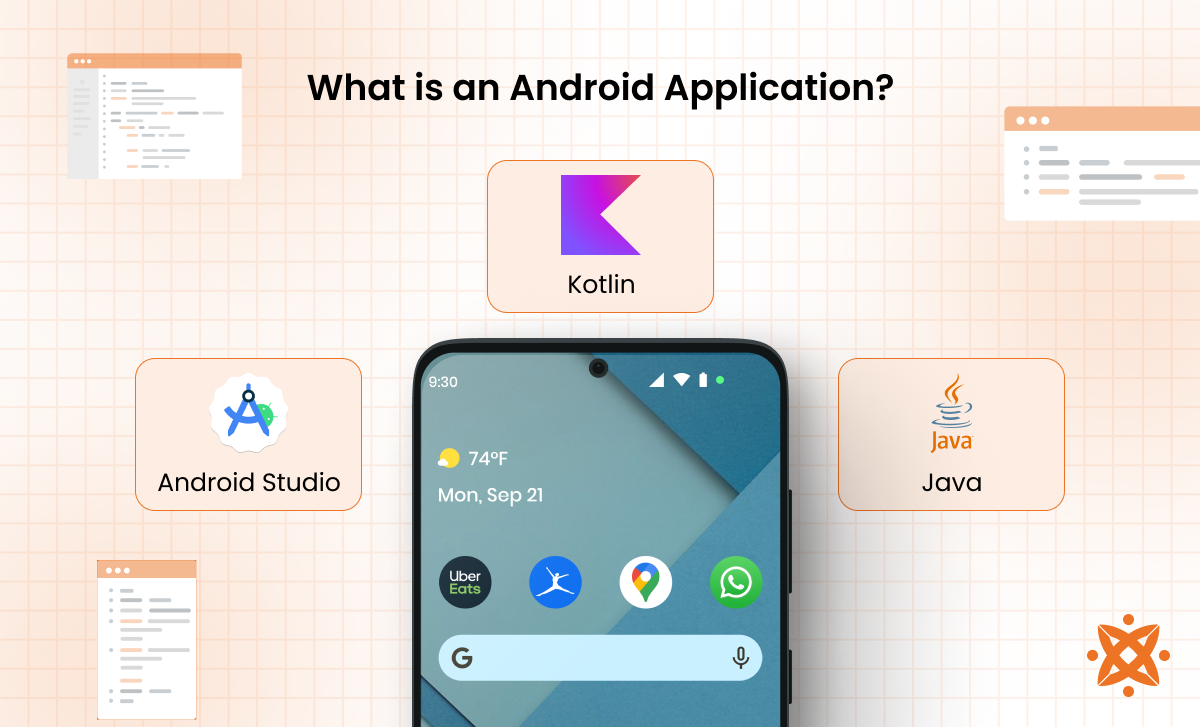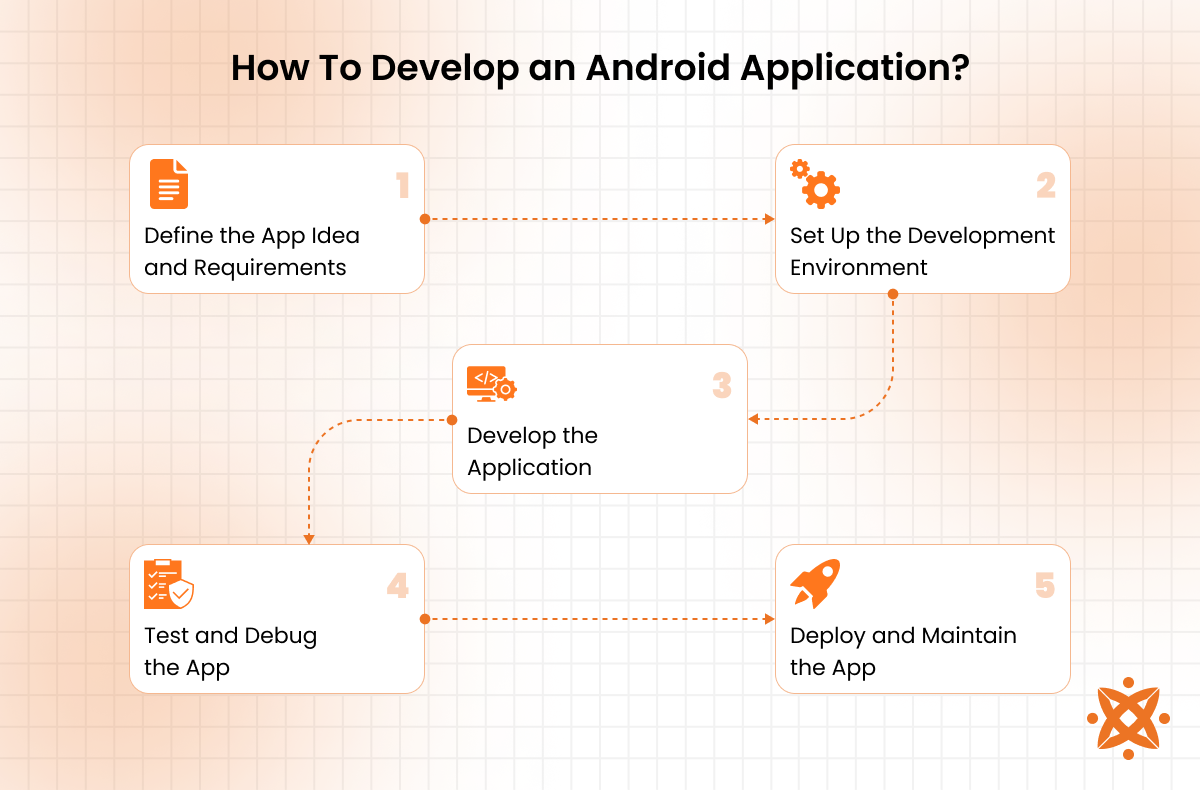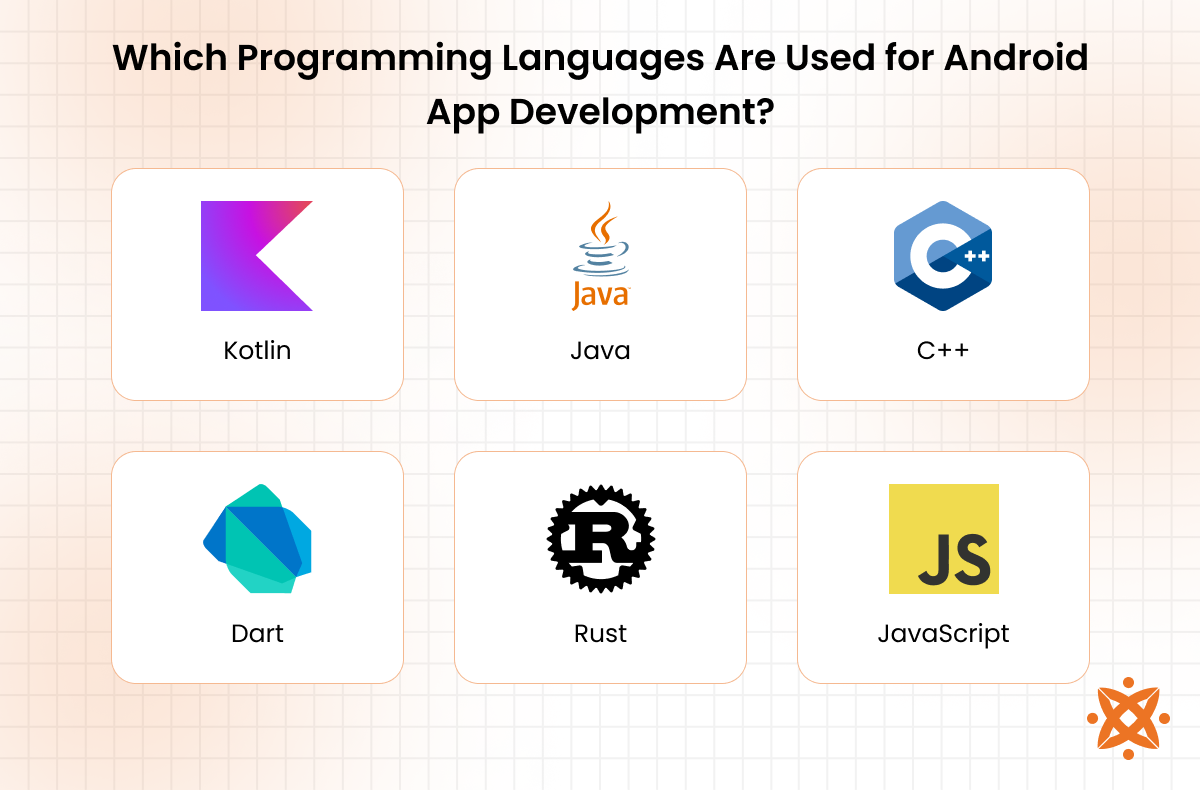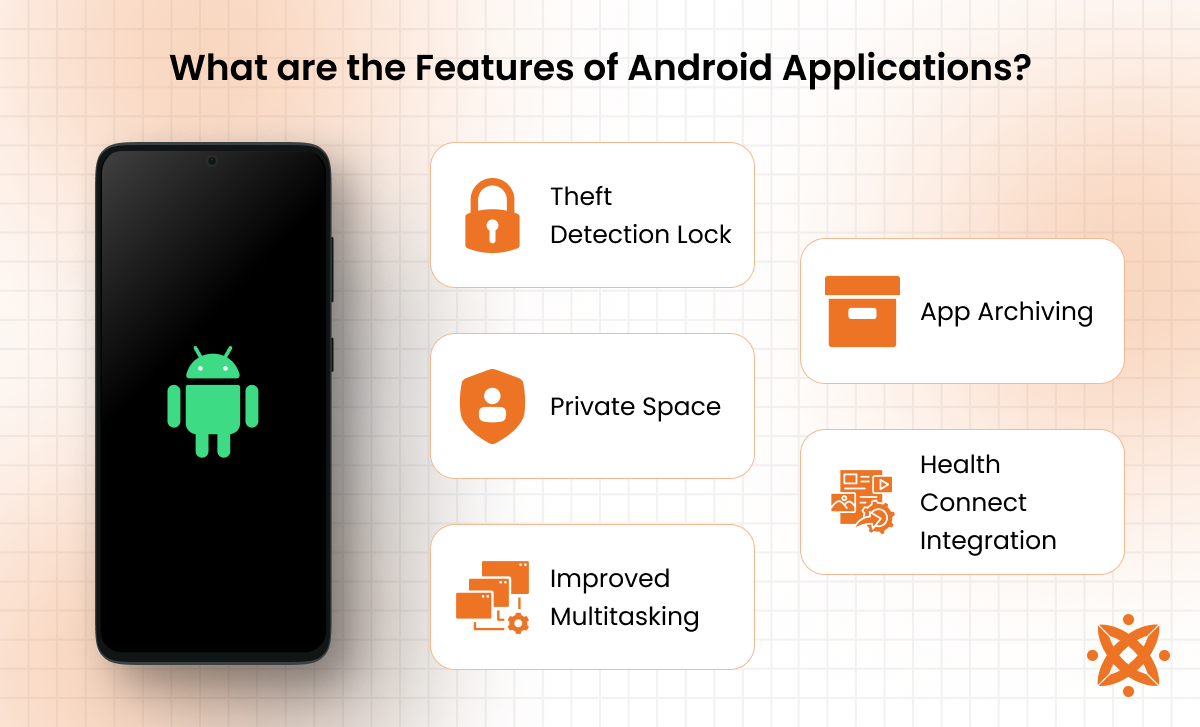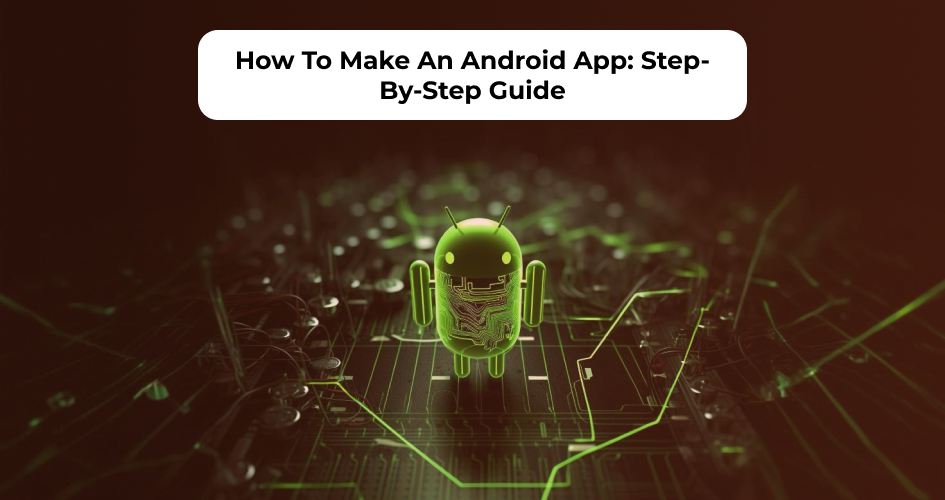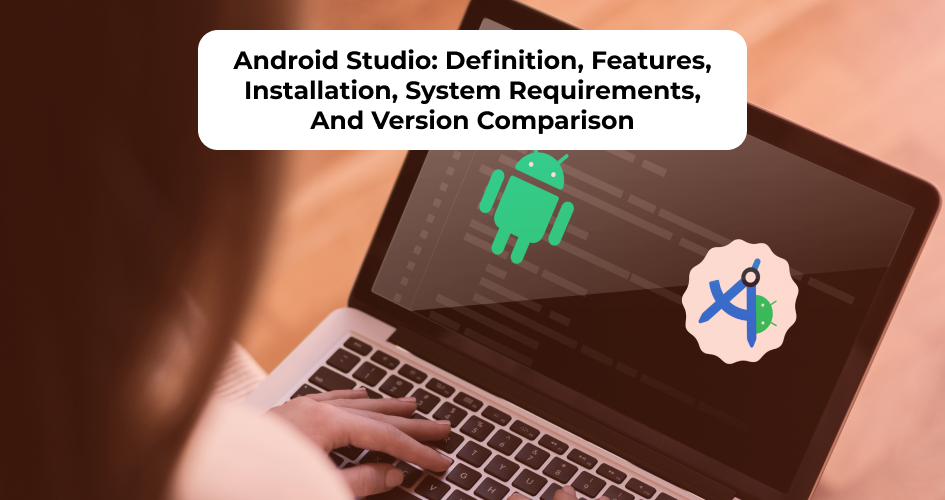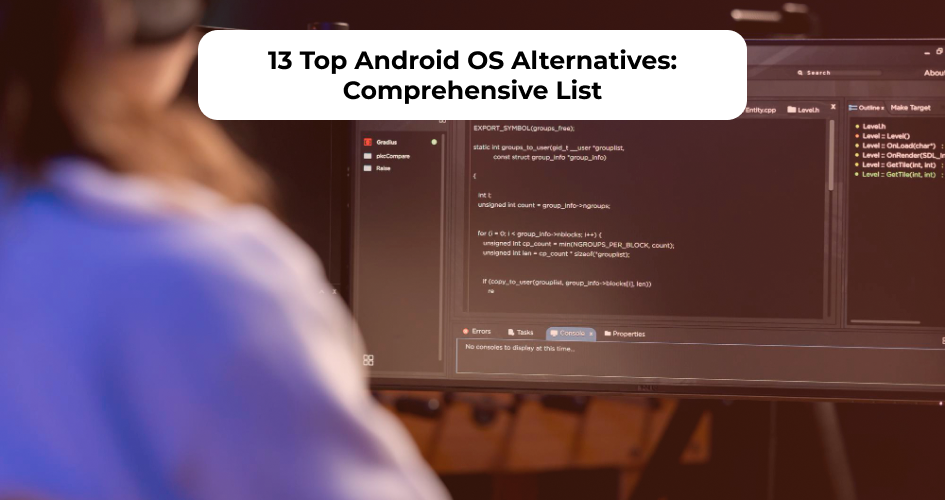An Android application is a software program designed to run on devices powered by the Android operating system, enabling users to perform a wide range of tasks, from communication to entertainment.
The Android operating system, developed by Google, is a Linux-based platform that powers a majority of smartphones globally. It is known for its open-source nature and extensive customization options.
In the United States, the app market generated $44.9 billion in 2023, with 12.5 billion apps downloaded and users spending 217 billion hours on mobile apps, as reported by Bussines of Apps in “US App Market Statistics.”
Android application development involves creating software applications for devices running the Android OS, utilizing programming languages such as Java and Kotlin.
The development process includes steps like planning, designing the user interface, coding, testing, and deployment, each important for building a functional and user-friendly app.
The cost of developing an Android app varies widely, ranging from $20,000 to $150,000, depending on factors like app complexity, features, and the development team’s location, as studied by Talent.com.
What is an Android Application?
An Android application is a software program designed to run on devices powered by the Android operating system. These applications are developed using Android programming, primarily in languages like Java and Kotlin, and they run within the Android runtime environment. Android apps cater to various functionalities, including communication, entertainment, productivity, and gaming, making them a core part of the mobile ecosystem.
The history of Android apps dates back to 2008 when Google launched the first commercial version of the Android operating system alongside the Android Market (now Google Play Store). Initially, Android was developed for digital cameras but later evolved into a mobile OS after Google acquired Android Inc. in 2005.
The first Android smartphone, the HTC Dream (T-Mobile G1), was released in 2008, supporting third-party applications developers could create using the Android SDK. Over the years, Android has grown into the world’s most widely used mobile operating system, with millions of apps available for download.
Android was developed by Android Inc., a startup founded by Andy Rubin, Rich Miner, Nick Sears, and Chris White in 2003. However, in 2005, Google acquired the company and continued its development, leading to the first official Android release in 2008. Google has overseen the development of Android, regularly updating it with new features, security improvements, and optimizations.
The executable file of an Android application is called an APK (Android Package). It is the format used to distribute and install apps on Android devices. An APK file contains all the necessary components of an app, including code, resources, assets, and manifest files. When installed, the Android system processes the APK, ensuring compatibility and security before execution.
According to a recent report by Global App Testing, the US Android app development market is substantial, with the US leading in revenue generation within the app development sector, projected to reach around $74.83 billion in 2022. the Android app development market globally is expected to generate around $935 billion in revenue in 2025.
What is the Android Operating System?
The Android operating system is an open-source, Linux-based platform developed by Google for mobile devices such as smartphones and tablets. It provides a user-friendly interface and supports a vast ecosystem of applications, enabling users to perform a wide range of tasks, from communication and entertainment to productivity and navigation.
Android’s journey began in 2003, but the first operating system was officially unveiled in 2007. The first commercial Android device, the HTC Dream (the T-Mobile G1), was released in 2008. Over the years, Android has evolved through numerous versions, each introducing new features and improvements, solidifying its position as the world’s most widely used mobile operating system.
Google owns and maintains the Android operating system, overseeing its development and distribution. While the core of Android is open-source, allowing developers and manufacturers to modify and adapt it, Google also provides proprietary services and applications, such as the Google Play Store and Google Mobile Services, which are integral to the Android ecosystem.
The development of the Android OS involves several programming languages. The system’s core components are primarily written in Java and C++, with some parts implemented in C. Kotlin has become a preferred language for Android application development in recent years due to its concise syntax and modern features. Languages like Go, Rust, and Assembly are also utilized in various aspects of the system to improve performance and security.
As of February 6, 2025, the latest version of the Android operating system is Android 14, released on October 4, 2024. This version introduces features such as predictive back gestures, improved system performance, enhanced privacy controls, and expanded support for foldable devices.
What is Android Application Development?
Android application development is the process of creating software applications that run on devices powered by the Android operating system. This involves designing, coding, testing, and deploying applications distributed through the Google Play Store or other platforms. Developers use Android software development techniques to build feature-rich, efficient, and scalable applications for various use cases, including business, entertainment, and productivity.
The primary Integrated Development Environment (IDE) used for Android application development is Android Studio, officially supported by Google. Android Studio provides a comprehensive suite of tools, including a code editor, emulator, debugger, and performance analyzer, making it the standard choice for developers. It integrates smoothly with the Android SDK and allows easy app testing on multiple devices.
The main programming languages used in Android software development are Java and Kotlin. Java was historically the default language for Android apps, but Kotlin has gained prominence due to its modern syntax, enriched safety features, and better interoperability with existing Java code. Developers use C++ for performance-critical components and Dart for cross-platform development with Flutter.
For professional Android application development services, businesses seek expert developers to create tailored mobile solutions that align with their goals and user expectations.
Who is an Android Developer?
An Android developer is a software professional who specializes in designing, building, and maintaining applications for devices running the Android operating system. These developers use Android software development techniques to create apps for various purposes, from social networking and gaming to business and healthcare solutions.
Android app developers are responsible for writing efficient code, debugging applications, optimizing performance, and ensuring compatibility across different Android devices. They integrate features like authentication, databases, push notifications, and real-time updates with APIs, third-party libraries, and backend services. Android developers follow UI/UX guidelines to create user-friendly interfaces.
An Android developer must have expertise in Kotlin and Java, the primary programming languages for Android apps. Knowledge of C++ is beneficial for performance-intensive applications. They must also be proficient in Android Studio, the official IDE, and frameworks such as Jetpack, Compose, and Retrofit for UI development and networking. Familiarity with Firebase, RESTful APIs, and SQL/NoSQL databases is also necessary. Other valuable skills include using version control systems (Git), writing unit and UI tests, and understanding Android security best practices.
An expert Android developer builds various types of applications, including e-commerce apps, social media platforms, gaming applications, fintech solutions, healthcare apps, educational tools, and enterprise applications. Depending on their expertise, they also develop cross-platform apps using frameworks like Flutter or React Native to extend their reach beyond Android devices.
How To Develop an Android Application?
To develop an Android app, a developer follows a structured process that involves designing, coding, testing, and deploying the application using Android software development techniques. This process ensures the app is functional, user-friendly, and optimized for different devices.
To develop an Android app, the following steps are implemented:
1. Define the App Idea and Requirements
The first step is identifying the app’s purpose, target audience, and core features. Developers conduct market research to analyze competitors and user needs. Creating wireframes and mockups helps visualize the app’s layout and functionality before development begins. Tools like Figma or Adobe XD are used for the UI/UX design of an Android application.
2. Set Up the Development Environment
Developers install Android Studio, the official IDE for Android development, and configure the Android SDK. They also select a programming language, Kotlin or Java, to write the app’s code. Version control systems like Git (via GitHub or GitLab) are set up to manage code efficiently at this stage.
3. Develop the Application
This involves coding the app’s frontend (UI) and backend (logic and database). Developers use Jetpack Compose or XML for UI design, Retrofit for API integration, and Room Database or Firebase for data storage. Example: A food delivery app requires user authentication, real-time tracking, and a payment gateway.
4. Test and Debug the App
Testing ensures the app functions as expected across different devices and Android versions. Developers use JUnit for unit testing, Espresso for UI testing, and Android Emulator or real devices for performance testing. Debugging tools in Android Studio help identify and fix errors. Example: Testing a social media app for image uploads and notifications.
5. Deploy and Maintain the App
Once testing is complete, the app is packaged into an APK or AAB file and submitted to the Google Play Store. Developers follow Play Store guidelines, optimize the app for SEO, and monitor analytics for user feedback. Continuous updates and security patches ensure the app remains functional and competitive. Example: An e-commerce app adding new payment methods after launch.
How Much Does it Cost to Develop an Android Application?
It costs between $15,000 and $150,000 to develop an Android application. This range varies significantly based on app complexity, features, design, and the development team’s location and expertise. For instance, a basic app with minimal features is on the lower end of the spectrum, while a complex app with advanced functionalities approaches or exceeds the higher end of mobile app development cost.
How Much Time Does It Take to Develop an Android Application?
It takes approximately 2 to 4 months to develop an Android application. This timeframe includes various stages, such as planning, UI/UX design, coding, testing, and deployment. The exact duration depends on the complexity of the app, the required features, and the development team’s expertise.
A simple app with minimal functionality is developed in 1 to 3 months, while a moderately complex app with integrations and advanced UI takes 4 to 6 months. Highly complex apps, such as enterprise solutions or advanced gaming applications, require 7 months or more for full development. The app development timeline varies significantly based on project scope, team size, and required technologies.
Which Programming Languages Are Used for Android App Development?
Programming languages that are used for Android app development are Kotlin, Java, C++, and Dart. These languages are important for building efficient, scalable, and feature-rich applications. Each language offers unique advantages, making it suitable for different development needs.
The following are programming languages used for Android app development:
- Kotlin: Kotlin is the official and most preferred language for Android app development, endorsed by Google since 2017. It is a modern, concise, and statically typed language designed to eliminate common coding errors. Kotlin offers enhanced safety features, better null handling, and smooth interoperability with Java, making migration easier for existing Android projects. It significantly reduces boilerplate code, improving productivity. Kotlin has a steeper learning curve for beginners transitioning from Java.
- Java: Java was the primary language for Android development before Kotlin’s adoption. It is an object-oriented language known for its stability, extensive libraries, and strong community support. Java applications run on the Android Runtime (ART) using the Java Virtual Machine (JVM). While Java remains widely used, it involves more boilerplate code and is prone to NullPointerException errors, which Kotlin addresses more efficiently.
- C++: C++ is used for performance-intensive applications, such as gaming and real-time processing apps, through the Android NDK (Native Development Kit). It provides high-speed execution and better memory management but is more complex due to manual memory allocation and debugging challenges. Unlike Kotlin or Java, C++ is not used for full-fledged Android apps but for optimizing required components.
- Dart: Dart is the programming language behind Flutter, Google’s cross-platform UI toolkit for Android and iOS development. It is known for its hot reload feature, which speeds up development and debugging. Dart allows developers to write a single codebase for multiple platforms, reducing development time. Flutter apps tend to have larger APK sizes compared to native Android apps, and Dart has a smaller developer community than Java or Kotlin.
- Rust: Rust is gaining attention in Android development, particularly for system-level programming and security-focused applications. It offers memory safety without a garbage collector, reducing vulnerabilities like buffer overflows. Google has started integrating Rust into Android’s low-level components, but it is not yet a mainstream choice for app development.
- JavaScript (React Native): JavaScript is used with the React Native framework to build Android and iOS apps from a single codebase. It allows for faster development and cost-effective cross-platform compatibility. React Native apps experience performance limitations compared to native apps, making it less suitable for high-performance applications.
What Frameworks are Used to Develop Android Applications?
Frameworks used to develop Android applications are Android Jetpack, Flutter, React Native, Xamarin, Ionic, Apache Cordova, and Unity. These Android application development frameworks provide necessary tools, libraries, and pre-built components that simplify the development process, enhance performance, and support cross-platform compatibility where needed.
Frameworks used to develop Android applications are as follows:
- Android Jetpack
- Flutter
- React Native
- Xamarin
- Ionic
- Apache Cordova
- Unity
What Are the Latest Trends in Android Development?
The latest trends in Android development include the integration of Artificial Intelligence (AI) and Machine Learning (ML), the adoption of 5G technology, the rise of cross-platform development frameworks, the emphasis on security enhancements, and the utilization of Augmented Reality (AR) and Virtual Reality (VR). These trends are shaping the future of mobile applications, focusing on enhanced user experiences, advanced technologies, and improved performance.
Integrating AI and ML into Android apps allows for more personalized and intuitive user experiences. Developers utilize these technologies to create smarter applications that predict user behavior and offer tailored content.
The widespread adoption of 5G technology revolutionizes Android app development by providing faster data transfer rates and lower latency. This advancement enables developers to create more responsive and data-intensive applications, enriching functionalities like streaming, gaming, and real-time analytics.
Cross-platform development frameworks, such as Flutter and React Native, are gaining popularity among developers. These frameworks allow for the creation of applications that run effortlessly on multiple platforms, reducing development time and costs while maintaining a native-like performance and user experience.
Security remains a top priority in Android development. Developers are implementing advanced security measures, including biometric authentication and blockchain technology, to protect user data and ensure privacy. This focus on security is important as cyber threats become more sophisticated.
AR and VR technologies in Android applications are expanding, offering immersive experiences in gaming, education, and retail. These technologies provide users with interactive and engaging environments, enhancing the overall user experience.
What are the Features of Android Applications?
The key features of Android applications are their adaptability, user-friendly interfaces, and smooth integration with device hardware and software. These Android app features enable developers to create versatile apps that cater to a wide range of user needs and preferences.
In the latest version, Android 15, the following notable features have been introduced to enhance security, performance, and user experience:
- Theft Detection Lock: This AI-powered feature detects sudden motion or behavior patterns that indicate theft, such as snatching from a user’s hand or rapid movement away from a location. Once triggered, the device automatically locks, preventing unauthorized access to data. This adds an extra layer of protection, reducing the risk of data breaches in case of theft.
- Private Space: Android 15 introduces a Private Space, allowing users to create a hidden, password-protected section within their device. This space stores sensitive applications, such as financial apps, private messaging platforms, or confidential documents. It remains invisible until unlocked, ensuring privacy and security from unauthorized access.
- Improved Multitasking: The update improves multitasking, particularly for foldable devices and tablets. With App Pinning, users keep specific apps in view while switching between multiple tasks. The split-screen and multi-window functionalities have also been refined, making it easier to manage multiple apps simultaneously without performance drops.
- App Archiving: Instead of deleting unused apps, users now archive them. This feature helps free up storage space while retaining app data, allowing users to restore archived apps without reinstalling them. This is particularly useful for users who need to manage storage efficiently but don’t want to lose app progress or settings.
- Health Connect Integration: With Android 15, Google has enhanced Health Connect, a unified hub for managing and sharing health and fitness data. This feature allows users to sync health-related data from various fitness apps, smartwatches, and medical devices securely. It also provides better control over data sharing, enabling users to decide which apps access specific health metrics.
What is the Difference Between Android App Development and iOS App Development?
The main difference between Android app development and iOS app development is the operating system they are built for. Android apps run on Google’s Android OS, while iOS apps run on Apple’s iOS. This distinction affects various aspects of development, including programming languages, development tools, design guidelines, and app distribution.
Android apps are primarily developed using Kotlin or Java, while iOS apps are built with Swift or Objective-C. Android development relies on Android Studio, whereas iOS development uses Xcode. Another key difference lies in the app store policies. Android apps are published on the Google Play Store, which has a relatively lenient review process, while iOS apps go through a stricter approval process on the Apple App Store.
From a design perspective, Android follows Material Design, offering more customization options across various device manufacturers, whereas iOS follows Human Interface Guidelines, ensuring consistency across Apple devices.
Android vs iOS app development differs in market reach. Android has a larger global user base, especially in developing regions, while iOS dominates in markets like the US and Europe with higher revenue potential. These differences impact how developers approach building, optimizing, and monetizing applications for each platform.
What Is the Architecture of an Android App?
The architecture of an Android app is a structured framework that defines how different components of an application interact to ensure scalability, maintainability, and efficiency. Android applications follow a multi-layered architecture comprising important components responsible for UI, data handling, and system interactions.
At its core, Android architecture is based on four main components: Activities, Services, Broadcast Receivers, and Content Providers. Activities manage the user interface and interactions, ensuring smooth navigation between different screens. Services handle background processes, such as music playback or notifications, running independently of the UI.
Broadcast Receivers enable the app to respond to system-wide broadcast events, like battery status or network changes. Content Providers manage data sharing between apps, allowing access to stored content such as contacts, files, or databases.
Modern Android development follows recommended Android architecture patterns like MVVM (Model-View-ViewModel) to separate concerns and improve code organization. These principles ensure that Android apps are modular, responsive, and adaptable to various screen sizes and device capabilities.
What is the Average Salary of an Android Application Developer?
The average salary of an Android application developer in the United States is approximately $126,357 per year, or $60.75 per hour, according to Talent.com. Entry-level positions start at around $104,984 annually, while experienced developers earn up to $159,984 per year. Globally, salaries vary based on factors such as location, experience, and demand. In the U.S., the higher cost of living and strong demand for tech talent contribute to these elevated salary figures.
Can I Create an Android App without Coding?
Yes, it is possible to create an Android app without coding. No-code platforms like Adalo and Thunkable allow users to design and develop apps using visual interfaces and pre-built components, eliminating the need for traditional programming knowledge. These tools are handy for individuals or businesses looking to quickly prototype or deploy applications without investing in extensive development resources.
Is it Possible to Develop Android Apps with Python?
Yes, it is possible to develop Android apps using Python. Frameworks like Kivy and BeeWare enable developers to write Android applications in Python, offering an alternative to Java or Kotlin. These frameworks do not provide the same level of performance or access to native features as traditional Android development tools, and the developer community and support resources are comparatively smaller.
Can I Build Android Apps Using React Native?
Yes, you can build Android apps using React Native. Developed by Facebook, React Native is a popular framework that allows developers to create cross-platform applications for both Android and iOS using JavaScript and React. It provides near-native performance and a rich set of pre-built components, making it a favored choice for many developers aiming to maintain a single codebase across multiple platforms.
Can I Build Android Apps Using Flutter?
Yes, you can build Android apps using Flutter. Flutter is an open-source UI toolkit developed by Google that enables developers to create natively compiled mobile, web, and desktop applications from a single codebase. It uses the Dart programming language and offers a rich set of customizable widgets, allowing for fast development and expressive UIs.
Can I Build Android Apps Using Xamarin?
Yes, you can build Android apps using Xamarin. Owned by Microsoft, Xamarin is a cross-platform development framework that allows developers to create Android and iOS applications using C#. It provides access to native APIs and tools, enabling the creation of high-performance applications with a native look and feel. Xamarin.Forms, a framework feature, allows for the development of a single UI shared across platforms, further facilitating the development process.

